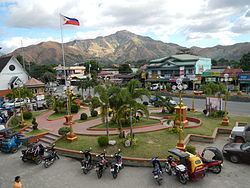Founded 1849 Time zone PST (UTC+8) Local time Saturday 8:27 PM | District 2nd district Barangays Area 188.1 km² | |
 | ||
Weather 27°C, Wind NE at 5 km/h, 71% Humidity Neighborhoods Pundaquit, Purok 1, Purok 3, Purok 4, Purok 6, Purok 5, Purok 2B Points of interest Anawangin Beach, Nagsasa Cove, Capones Island Lighthouse, Talisayen Cove, Jimz Beach Resort | ||
San antonio zambales philippines
San Antonio is a second class municipality in the province of Zambales in the Philippines. According to the 2015 census, it has a population of 34,661 people.
Contents
- San antonio zambales philippines
- Map of San Antonio Zambales Philippines
- History
- Geography
- Demographics
- Tourist attractions
- Education
- Sports
- Notable people from San Antonio
- In Film
- References
Map of San Antonio, Zambales, Philippines
History
San Antonio was a hunting region where indigenous hunters from the northern towns of Zambales would hunt, and gather. The first settlers from the Paoay area in Ilocos Norte arrived in 1830, and founded the first Spanish settlement that developed into what is now San Antonio.
San Antonio was given the status of district or barrio in 1836. The town mayor in that period was Don Gregorio Banaga. He governed the town from 1836 to 1849. He was succeeded by Don Vicente Lacuesta in 1849, from Teniente Primero to Teniente Absoluto. The last mayor was Don Santiago Ladrillono. He was succeeded by Don Dimas Pascasio as governor in 1856. They selected their leaders every year. In 1891 to 1898, Don Pablo Corpus was the only Capitan Municipal selected then appointed Don Felix Magsaysay as the first President municipal, and many more followed up to 1931 to 1945.
The town was the site of the United States Navy Base known as the U.S. Naval Communications Station San Miguel. After the earthquake and eruption of Mount Pinatubo in 1991, the United States Military decided to abandon its military bases in the Philippines.
Geography
San Antonio is politically subdivided into 14 barangays.
Demographics
In the 2015 census, the population of San Antonio, Zambales, was 34,661 people, with a density of 180 inhabitants per square kilometre or 470 inhabitants per square mile.
Tourist attractions
San Antonio is increasingly known for its beautiful beaches, majestic mountains and scenic coves. It is a favorite destination of campers and beach lovers.
Education
Sports
San Antonio, influenced by the presence of the United States Naval Communication Station in the late 50's, is the baseball and softball capital of Zambales. Mayor Zozimo Pascasio and the Holy Name Society adopted the program in the 60's and 70's. Their partnership produced players who became athletic scholars in various colleges and universities in Manila. In the early 80's, JJ Henry & Chuck Jones of FRA Branch 367 (US Navy retirees) living in San Antonio, further enhanced the enthusiasm for the sport through the Shipmates, a team of 10- to 12-year-old boys coming from the different barangays who competed in the PABA (Philippine Amateur Baseball Association) Invitational. In 1985, the core of the team intact & playing for TR Yangco Educational Institute, the Shipmates coached by Butch Echiverre, won the baseball gold in the CLRAA (Central Luzon Regional Athletic Association), a first for Zambales. The San Antonio "TNT" Jaycees, most of whom are employees at the US Navy base, continued the program with their annual San Antonio Summer Baseball Cup successfully.
After the eruption of Mt Pinatubo in 1991, due to the destruction of the playing fields and the withdrawal of the US bases, support for the baseball program dwindled. Eager to find an alternative sports activity, Butch Echiverre and some friends introduced darts to the community. From its humble beginnings at a place called "Kubo," presently, the Zambales Darters Federation is considered as one of the best dart organizations in the country for having hosted several national competitions. Its "no-school, no-play" policy is now adopted nationwide and the NDFP (National Darts Federation of the Philippines) conferred the President's Award to the group during the Darterong Pinoy 2012.
The community's love for baseball was rekindled in the late 90's after losing the provincial baseball crown to Botolan, Zambales. The SADTEA (San Antonio District Teachers & Employees Association) took the initiative of organizing an inter-school tournament. This time, a softball tournament for girls is included. Supported by some officials of the local government and equipment donated by San Antonians locally & abroad, San Antonio baseball/softball is better than it ever was. As a member of the Little League Asia Pacific Region, San Antonio has always reached the quarterfinals of the Philippine Series. Irwin Mata is the Little League President of San Antonio.
Aside from fast becoming a surfing capital of Luzon, San Antonio has an 18-hole golf course at the Naval Education and Training Command of the Philippine Navy (formerly US Naval Communication Station).
